More than once I’ve been told by fellow travelers not to bother visiting the city of Cologne, Germany. “Don’t waste your time,” they said. “The only thing to see is the cathedral.” So when I realized that Cologne was the first German city to be visited on my Viking River Grand European Tour, I was prepared to be underwhelmed.
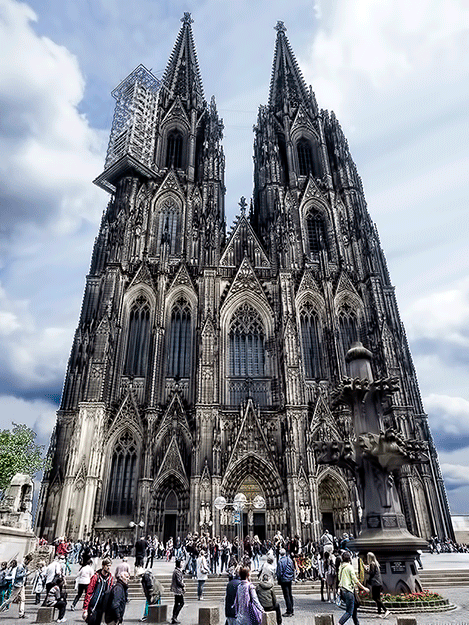
We began our walking tour in front of the Kölner Dom, as the cathedral is known in German, a UNESCO World Heritage Site said to be the largest Gothic cathedral in northern Europe. My first impression was disappointment at the sooty facade, which has been blackened by a combination of natural oxidation and the smoke from steam locomotives that used to pull into the train station next door. But soon, details began to emerge: pointed arches dressed with elaborate geometric decorations, twin towers that soar to a height of 515 feet, an entrance lavish with 19th century statuary, and the flying buttresses that allowed medieval builders to build such a cavernous structure.
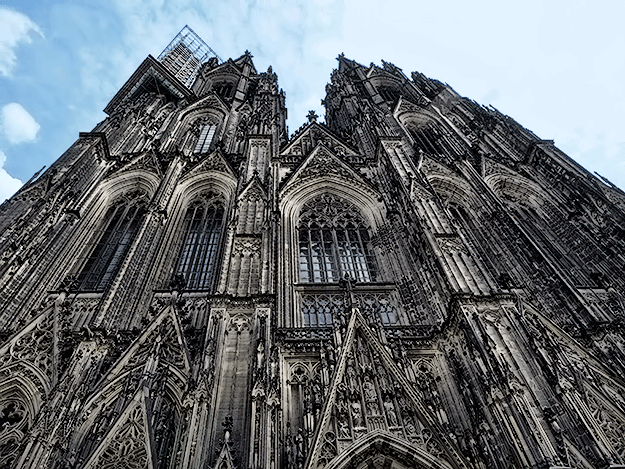
Unfortunately, we had arrived on a Sunday, and the cathedral was closed for services. Our guide assured us we would have free time after the tour and could return later to see the interior, then led us away to see the rest of Cologne. In front of the Romano-German museum, we viewed the remains of a Roman Dionysus mosaic, then proceeded to Fishmarket Square, which was built 2000 years ago atop what was a Roman warehouse. We strolled through Old Market Square to Haymarket Square, stopping at 4711, home of the Original Eau de Cologne. It was a pretty enough town, but I was itching to get back to the cathedral, and when the church bells rang high noon I was waiting at the door.
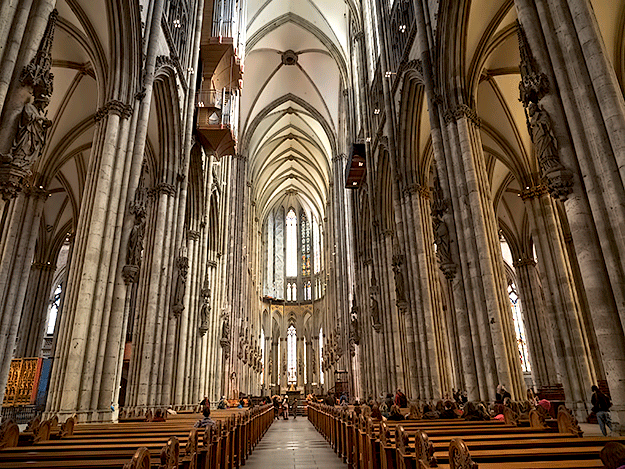
Inside I paused, allowing my eyes to adjust to the gloom. It is said the goal of Gothic architecture is to draw the eyes upward, toward heaven, and the Cologne Cathedral achieves that goal with jaw-dropping magnificence. Sunlight streamed through soaring stained glass windows, suffusing the interior in warm golden hues. Lofty granite columns were adorned with precious sculptures. Marble sarcophagi containing the remains of former bishops reposed in chapels carved into the apse of the church. Even the mosaic floor was spectacular; created from millions of pieces of ceramic tesserae, it measures 1,350 square meters and is the largest work of art in the cathedral.
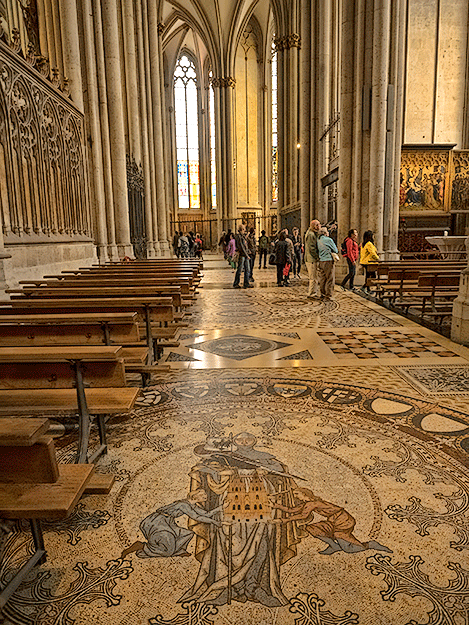

For more than two hours I circumnavigated the cross-shaped floor plan, perusing exquisite artworks, some of which of which date back to the tenth century. Even the Stations of the Cross were magnificent. Sculpted from sandstone between 1893 until 1898 by Utrecht-based artist Wilhelm Mengelberg, twelve of them hang in medieval altar niches in the nave, while the 13th and 14th are located on the ground floor of the south and north towers.

Madonna sculptures abounded, but two stood out. The first, created around 1420, depicts Madonna and Child standing on the bust of an angel. Affixed to a massive granite column, they look down benignly on worshipers, as they have been doing for almost 600 years.
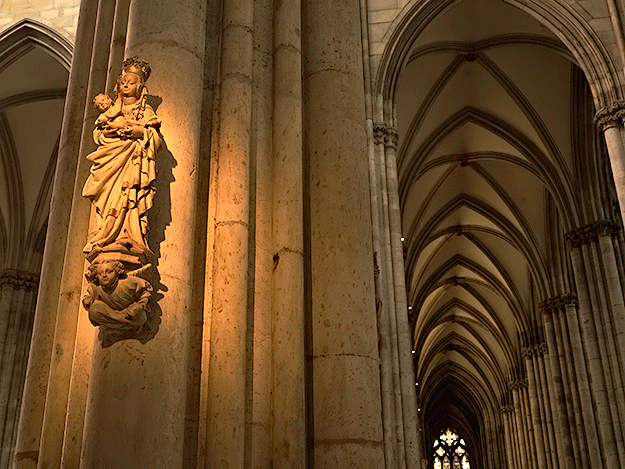
The Gothic Carving known as the Milan Madonna (upper right, in the photo below), made in the cathedral workshop around 1280-1290, is said to have miraculous powers. From her lofty perch, she seems to guard the Altar-piece of the city’s patron saints, painted sometime around 1442 by the Cologne-based artist Stefan Lochner. Today this a triptych is considered to be the most significant example of the Late Gothic Cologne school of painting.
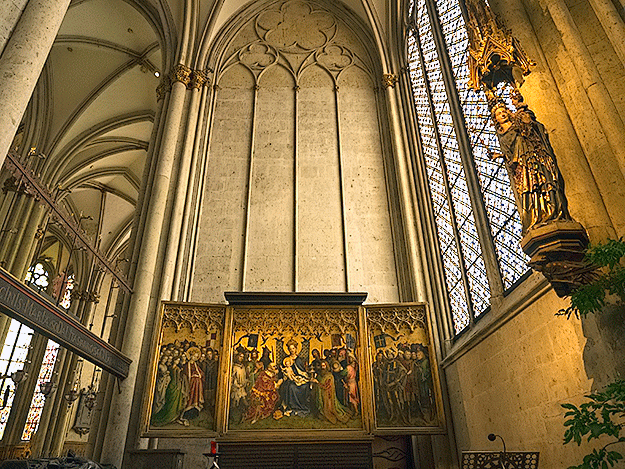
Yet another triptych, the St Agilulfus altar-piece, is one of the most important of all Antwerp carved altar-pieces. Created around 1520, this multiple-winged polychrome features scenes from the Passion of Christ as well as life stories of the two bishops St. Anno and St. Agilulfus.
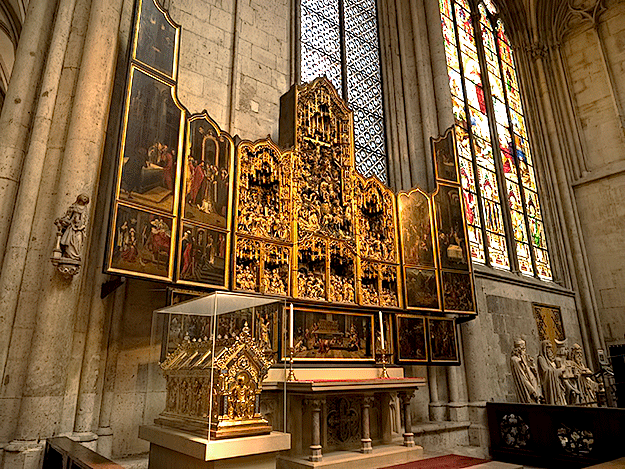
With sailing time fast approaching, I made one last round, concentrating on the stained glass windows that had struck me with such awe when I first entered the cathedral. The statues, artworks, mosaics, though impressive, all paled in comparison to these leaded glass masterpieces. I paused in front of a pair that caught my fancy, perhaps due to their vivid colors. The Görres window, made in the Royal Stained Glass Manufactory in Munich and installed in 1856, depicts Joseph Görres kneeling before Mary and the Christ Child. The St Peter window was donated in 1870 by the Rhenish Railroad Company and installed in 1876. The main scene shows the Council of Jerusalem with Saint Peter in the middle. Above, God gives St. Peter the keys of heaven and Pope Pius IX is shown with the Bull of Convocation for the First Vatican Council.
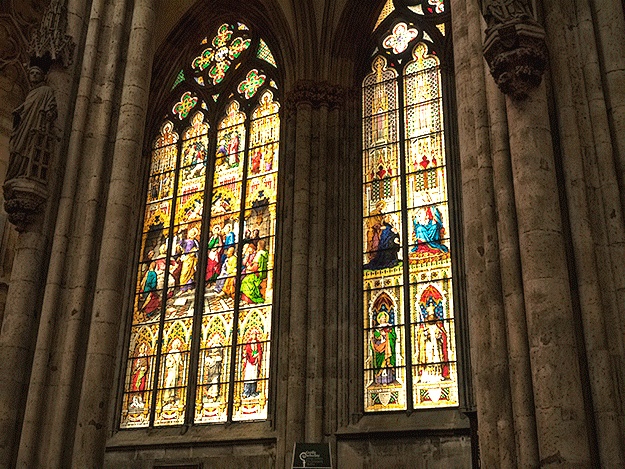
I smiled as left the cathedral, remembering what my friends had said about skipping Cologne. Not only do I disagree, I would go so far as to say that when in Germany, one must visit Cologne, especially to see its magnificent cathedral.
Note: I was a guest of Viking River Cruises during my Grand European Tour, however, the receipt and acceptance of complimentary items or services will never influence the content, topics, or posts in this blog. I write the truth, the whole truth, and nothing but the truth. Viking offers itineraries on the great rivers of the world, including destinations in Europe, Egypt, China, Southeast Asia, Russia, and soon, in the U.S.

Barbara this cathedral is amazing every detail . I think for me is a wonderfull place to visit alot of history inside and outside
It was wonderful, Izy. I could have stayed there another couple of hours. Hope you get to see it one day.
I was interested to read your article when I saw it in my twitter feed. What a stunning cathedral! I always wondered about Cologne since I have a quote framed on my wall I got some time ago. It reads –
“I believe in the sun even when it is not shining. I believe in love even when I cannot feel it. I believe in God even when He is silent.” it says – found written on a cellar wall in Cologne, Germany during the Holocaust
It is such a moving quote and it is nice to see some part of the beauty through your post!
oops, meant to say – What a stunning cathedral indeed!
Thanks so much Rachel, especially for sharing the sentiment on your plaque. Those kind of things just wrench my heart, because I can imagine the suffering that the writer must have endured. But I do have faith that we cannot know God’s plan, and that everything happens for a reason, though we’re rarely privy to the reasons. I guess maybe that would make life too easy. But it does help a little when I see and can share places of great beauty. I’m so pleased that you liked my article and photos, and that you took the time to leave me a comment.
I went inside to sit in a pew and rest my tired body. I was so overcome by the magnifence I forgot about being tired. I prayed for the first time in years.
I can easily see how it would have that effect Jane. I could barely tear myself away in time to get back to the ship before it sailed.
Beautiful pictures! I was blessed to have been able to experience this cathedral a few years back on a visit to Cologne while living in the Netherlands. It truly is a magnificent structure in every way possible. The city, as a whole, is fabulous, and definitely not one to be missed when planning a European trip.
I couldn’t agree more, Jill. In fact, it was one of the highlights of my Viking cruise.
Lovely photos! Luckily, I revisited Cologne in December when everything was Christmasy. I enjoyed the church and the surrounding area and definitely was NOT underwhelmed. 🙂
Ooh, aren’t the Christmas markets in Germany something else?? Christmastime in Europe is so magical!!
I’m with you, Joy – great city, especially for the Cathedral, but for everything else it has to offer as well.
The cathedral in Cologne was one of the most stunning sights I’ve ever seen. We walked out of the railway station and there it was on the left — so enormous! I was captivated by it the whole time we were in Cologne and loved climbing to the top– well, almost to the top! Great pics of it, Barbara.
Thanks so much, Cathy. It was absolutely one of the most impressive cathedrals I’ve ever seen, and I liked the town as well. But I got lazy and didn’t climb to the top 🙂
I loved that you were so taken by the Cologne cathedral as I was! I visited it in 1983 which was my first trip to Europe.It was one of my first stops and I’ll never forget it.I am a watercolor artist who loves European architecture but this cathedral blew me away.I loved the fact that in WWII the people of Cologne dismantled the mosaic windows,etc and hit them away in the countryside in order to save them from the bombs,etc.People in Europe have such a wonderful pride for their old art pieces.I wish Americans had that passion and pride for our history.We just tear the old down.
I hear you, Pat. Americans think a 100 year old house is no longer usable. It’s one of the reasons I love Europe so much.